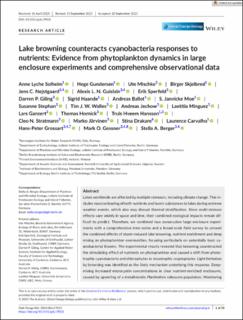| dc.contributor.author | Solheim, Anne Lyche | |
| dc.contributor.author | Gundersen, Hege | |
| dc.contributor.author | Mischke, Ute | |
| dc.contributor.author | Skjelbred, Birger | |
| dc.contributor.author | Nejstgaard, Jens Christian | |
| dc.contributor.author | Guislain, Alexis L. N. | |
| dc.contributor.author | Sperfeld, Erik | |
| dc.contributor.author | Giling, Darren P. | |
| dc.contributor.author | Haande, Sigrid | |
| dc.contributor.author | Ballot, Andreas | |
| dc.contributor.author | Moe, S. Jannicke | |
| dc.contributor.author | Stephan, Susanne | |
| dc.contributor.author | Walles, Tim J. W. | |
| dc.contributor.author | Jechow, Andreas | |
| dc.contributor.author | Minguez, Laetitia | |
| dc.contributor.author | Ganzert, Lars | |
| dc.contributor.author | Hornick, Thomas | |
| dc.contributor.author | Hansson, Truls Hveem | |
| dc.contributor.author | Stratmann, Cleo N. | |
| dc.contributor.author | Järvinen, Marko | |
| dc.contributor.author | Drakare, Stina | |
| dc.contributor.author | Carvalho, Laurence | |
| dc.contributor.author | Grossart, Hans-Peter | |
| dc.contributor.author | Gessner, Mark O. | |
| dc.contributor.author | Berger, Stella Angela | |
| dc.date.accessioned | 2024-01-16T12:55:36Z | |
| dc.date.available | 2024-01-16T12:55:36Z | |
| dc.date.created | 2023-12-04T12:53:47Z | |
| dc.date.issued | 2023 | |
| dc.identifier.citation | Global Change Biology. 2023, 30 (1), e17013. | en_US |
| dc.identifier.issn | 1354-1013 | |
| dc.identifier.uri | https://hdl.handle.net/11250/3111855 | |
| dc.description.abstract | Lakes worldwide are affected by multiple stressors, including climate change. This includes massive loading of both nutrients and humic substances to lakes during extreme weather events, which also may disrupt thermal stratification. Since multi-stressor effects vary widely in space and time, their combined ecological impacts remain difficult to predict. Therefore, we combined two consecutive large enclosure experiments with a comprehensive time-series and a broad-scale field survey to unravel the combined effects of storm-induced lake browning, nutrient enrichment and deep mixing on phytoplankton communities, focusing particularly on potentially toxic cyanobacterial blooms. The experimental results revealed that browning counteracted the stimulating effect of nutrients on phytoplankton and caused a shift from phototrophic cyanobacteria and chlorophytes to mixotrophic cryptophytes. Light limitation by browning was identified as the likely mechanism underlying this response. Deep-mixing increased microcystin concentrations in clear nutrient-enriched enclosures, caused by upwelling of a metalimnetic Planktothrix rubescens population. Monitoring data from a 25-year time-series of a eutrophic lake and from 588 northern European lakes corroborate the experimental results: Browning suppresses cyanobacteria in terms of both biovolume and proportion of the total phytoplankton biovolume. Both the experimental and observational results indicated a lower total phosphorus threshold for cyanobacterial bloom development in clearwater lakes (10–20 μg P L−1) than in humic lakes (20–30 μg P L−1). This finding provides management guidance for lakes receiving more nutrients and humic substances due to more frequent extreme weather events. | en_US |
| dc.language.iso | eng | en_US |
| dc.publisher | Wiley | en_US |
| dc.rights | Navngivelse 4.0 Internasjonal | * |
| dc.rights.uri | http://creativecommons.org/licenses/by/4.0/deed.no | * |
| dc.title | Lake browning counteracts cyanobacteria responses to nutrients: Evidence from phytoplankton dynamics in large enclosure experiments and comprehensive observational data | en_US |
| dc.type | Peer reviewed | en_US |
| dc.type | Journal article | en_US |
| dc.description.version | publishedVersion | en_US |
| dc.rights.holder | © 2023 The Authors | en_US |
| dc.source.pagenumber | 23 | en_US |
| dc.source.volume | 30 | en_US |
| dc.source.journal | Global Change Biology | en_US |
| dc.source.issue | 1 | en_US |
| dc.identifier.doi | 10.1111/gcb.17013 | |
| dc.identifier.cristin | 2208429 | |
| dc.source.articlenumber | e17013 | en_US |
| cristin.ispublished | true | |
| cristin.fulltext | original | |
| cristin.qualitycode | 2 | |

